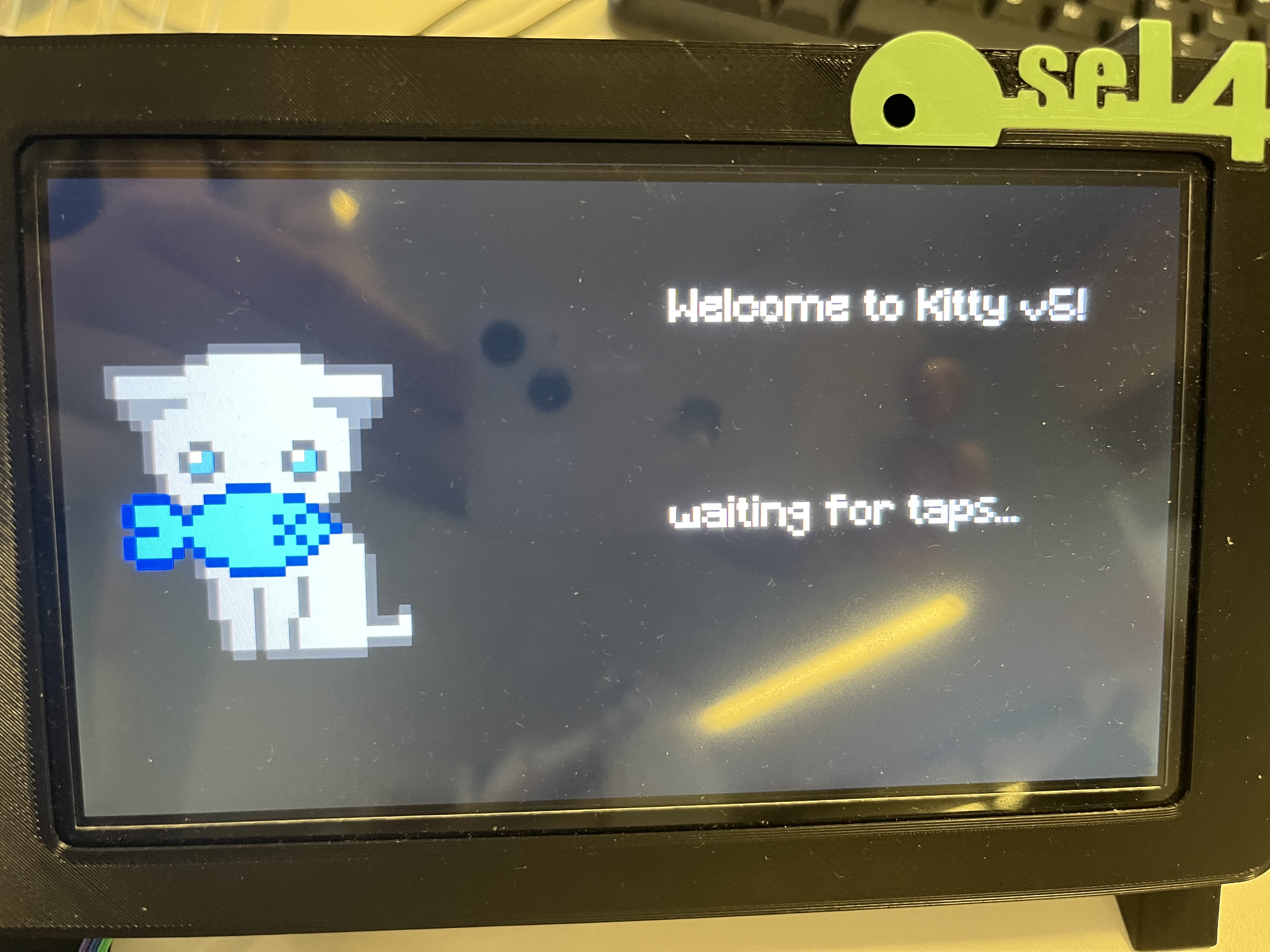Reference system #
Since LionsOS is trying to be a fundamentally different operating system, we need to teach people how to properly use it.
The purpose of this reference system is to show off a real, deployable system using a wide range of the components that LionsOS provides.

The system we have built is called the Kitty, it is a Point-of-Sale (PoS) system intended to be used for buying snacks in the Trustworthy Systems Lab.
This page describes the system’s architecture and details about how it works, if you are interested in building and running it see the pages on:
Architecture #
Below is a diagram of the (simplified) architecture of the Kitty system that contains all of the various components involved.
There is a client program which is inside the Kitty source code (client/kitty.py) that
when imported in the MicroPython REPL will do three things:
- scan for card taps
- send network requests and receive responses with a server to register card taps
- draw the UI based on the current state (e.g if someone has successfully tapped)
LionsOS components #
I2C #
For accessing the card reader, we have a I2C driver that is behind a virtualiser which clients communicate with to claim busses and send requests and receive responses.
Serial sub-system #
Interaction with the MicroPython REPL is done via a serial connection. We use a UART device.
Timer #
In order for functionality such as time.sleep() in MicroPython to work we need
to use a timer device. It is also required for each IP stack used for the NFS client
and MicroPython networking to deliver a regular timeout notification.
Linux Virtual Machine #
In order to have graphics, we use the graphics driver already in Linux and export a framebuffer to the Kitty client so that it can draw directly to the display.
This way we do not have to write a fairly complex graphics driver ourselves.
Linux images #
There are three images associated with the guest operating system:
- the kernel
- the Device Tree Blob (binary format of the Device Tree)
- the initial RAM disc/root file system
The manufacturers of the Odroid-C4 platform, HardKernel, have upstreamed support to mainline Linux.
This means that we have been able to use a standard mainline version of Linux to build and run virtual machines on the Odroid-C4. It has the necessary platform specific configuration and drivers.
However, for this example system there is a single driver that has not
been upstreamed. It is a driver for the lt8619c device which is the
HDMI bridge between the VU7C display and Odroid-C4.
MicroPython #
MicroPython is a Python interpreter designed for embedded use. It has a much smaller memory footprint than a standard Python implementation, and does not rely on a full operating system. It includes facilities for interacting directly with hardware; and is relatively straight-forward to port to a new environment.
We chose micropython as a way to develop business logic quickly for simple embedded systems. If appropriately configured, it can act as a shell for LionsOS.
The official documentation can be found at https://docs.micropython.org.
Porting MicroPython #
For this example system, we have not had to modify or patch MicroPython in any way, despite MicroPython not having official support for LionsOS. This is primarily because MicroPython allows users to add their own ports without changing any internal code.
MicroPython is very configurable, the minimum functionality MicroPython needs to run is a way to output and receive on a serial device. From there, everything added like timing, networking and file systems is up to what you need from MicroPython.
More information about porting can be found here.
Connections with LionsOS #
I2C #
The MicroPython I2C class is used to interact with an I2C bus.
Framebuffer #
In order to have a basic graphical user interface (GUI) we leverage the existing graphics driver in Linux in order to draw to a framebuffer.
We do this for two reasons:
- To show off virtual machines being used in a LionsOS-based system.
- At this stage, we do not have the capacity to write graphics drivers and our UI is not affected by the overhead of a virtual machine.
The framebuffer and associated configuration is exported via shared memory to a client, in this case MicroPython.
MicroPython provides a small framebuf
module for doing operations on a fixed size buffer (e.g setting a particular pixel to a certain colour).
Unlike some of the other modules we make use of in our port of MicroPython, framebuf does no I/O. For
this, we have a custom module called fb that simply allows us to send a buffer from MicroPython to
the display via the virtual machine.
This custom module was added following the process on
MicroPython’s documentation.
This module is built and linked at build-time in contrast to extending MicroPython using .mpy files. More information
about extending MicroPython here.